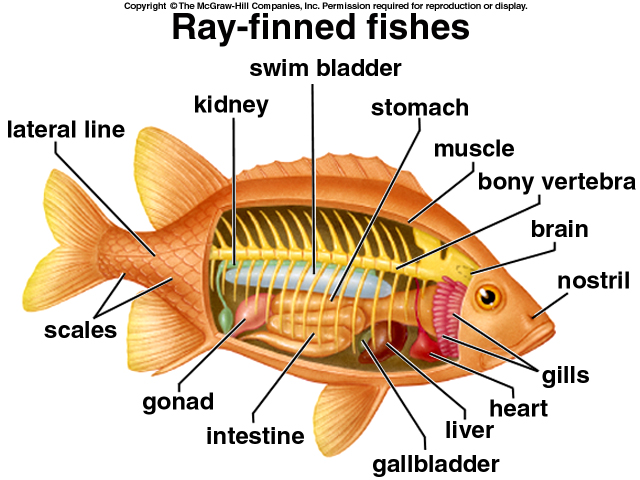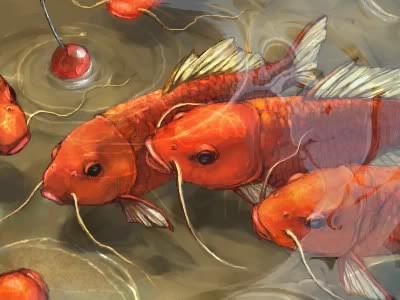Ahhh, Magikarp, one of the most enigmatic pokemon in the whole game. It seems to exist for no reason whatsoever. It's too weak to use in the beginning of the game, it takes forever to level up, it has abysmal stats (aside from sub par speed) and it is virtually unusable in the end levels. Strangely enough, it's evolution is the complete opposite as upon reaching the magical level of 20, it transforms into a rampaging blue behemoth that looks nothing like it's predecessor aside from a few anatomical features.
What gives? Why the sudden transformation? How does a pushover like Magikarp survive long enough to even become the bane of every Red and Blue playing child (It takes forever to kill this damn thing)? From a biological standpoint, how does Magikarp even still exist? Well, let's take a look.
Based on it's anatomy, it is clear that if Magikarp were to exist in reality, it would belong to the class, Actinopterygii, otherwise known as the ray finned fishes. More specifically, it would belong to the order, Cypriniformes, the group that constitutes carps and minnows. To get a better understanding of Magikarp as a species and how it fits into it's environment, I believe that it is best to check the fossil record in order to check for any past features that worked (and presumably did not work) in favor of the species survival.
There is a problem, however. The fossil record with pokemon is woefully incomplete as there are only about 17 recorded species, none of which are even remotely related to Magikarp. At this point, the true scientist must then resort to inference.
What we know:
1. According to Dexter (the pokedex), Magikarp's ancestors were presumably stronger than it is now. 2. Slow aquatic pokemon of the past (Omanyte, Omastar, Kabuto, Kabutops) were driven to extinction with the introduction of faster prey.
Thus, 3. It is not unreasonable to presume that Magikarp's ancestor was likely the "faster" prey item. It is also possible that they could have been the predator, given the fact that they were stronger and faster.
(Artist's rendition of possible ancestor to the Magikarp)
Why is it so common?
(Recent biosurvey result of PokeEarth. Most prevalent biomass is labelled with a graphic.)
Anyone who has ever played the games know just how common this fish is. They live in almost every single body of water on every continent with the rare exception of the Unova Region (there is speculation that they were wiped out by hyper competitive Basculin). This can actually be attributed to a variety of factors.
1. Magikarp can survive in practically any type of water, be it saline, fresh, or polluted.
This can be seen in many real life examples such as the black chin tilapia. In Hawaii, these fish are one of the most common species on the island, and being invasive, are also a nuisance. Quite often, I have seen them on the coastline, far from the mouth of any river or stream, and when I do see them inland, the water they reside in is often horrifically polluted, which is a testament to their hardiness. Species like these can capitalize on environments that would normally be inaccessible to other species.
2. They have a superior breeding strategy.
Okay, when a species is this common, you can bet your ass on one thing. It either has a lot of babies in a short amount of time, or the way it takes care of its offspring is incredibly successful. In this case, it's probably safe to say that Magikarp (or Gyarados) lays a lot of eggs. So Mr. Magikarp salesman was right to a degree. It's just the whole "getting filthy rich selling the eggs" is a little skeevy. What kind of marketing plan is that? Sell what the consumers want.
Adding to that, it's a fair bet to say that Gyarados is hyper aggressive and territorial; thus, it literally pushes all predators out of the area. More so, Magikarp may be able to spawn without having to complete their life cycle, which is seen in many types of fishes and amphibians like the axylotl. How an ecosystem is able to sustain such a large biomass of fish is a mystery to me however, but it is possible that they simply just eat anything they can or that they are cannibalistic. This brings up a behavioral adaptation that is unique to Magikarp (and it's relatives).
3. Splash.
Splash is a useful move. Granted it is absolutely USELESS in battle, that is not what Magikarp is designed to do. In the evolutionary grand scheme of things, it appears that Magikarp and it's relatives sacrificed power and defense in favor of a faster and streamlined body (see Placoderms). However, out of water, a fish cannot move. In this case, Magikarp actually can defy this land limitation by splashing. It can flipflop to different bodies of water and populate them in times of drought. This is the biggest explanation for their huge range. Certain catfish can do this, but it is a much slower process.
In times of crisis, splash could also be used as a defense mechanism to propel the fish in an erratic and unpredictable manner. It could cause a huge scene in which only one fish is killed for the benefit of the entire school; a type of altruism that is seen in many animals today. Some people may claim that it could invoke pity; a fish flopping around does indeed look pathetic but to a predator, this is irrelevant.










No comments:
Post a Comment